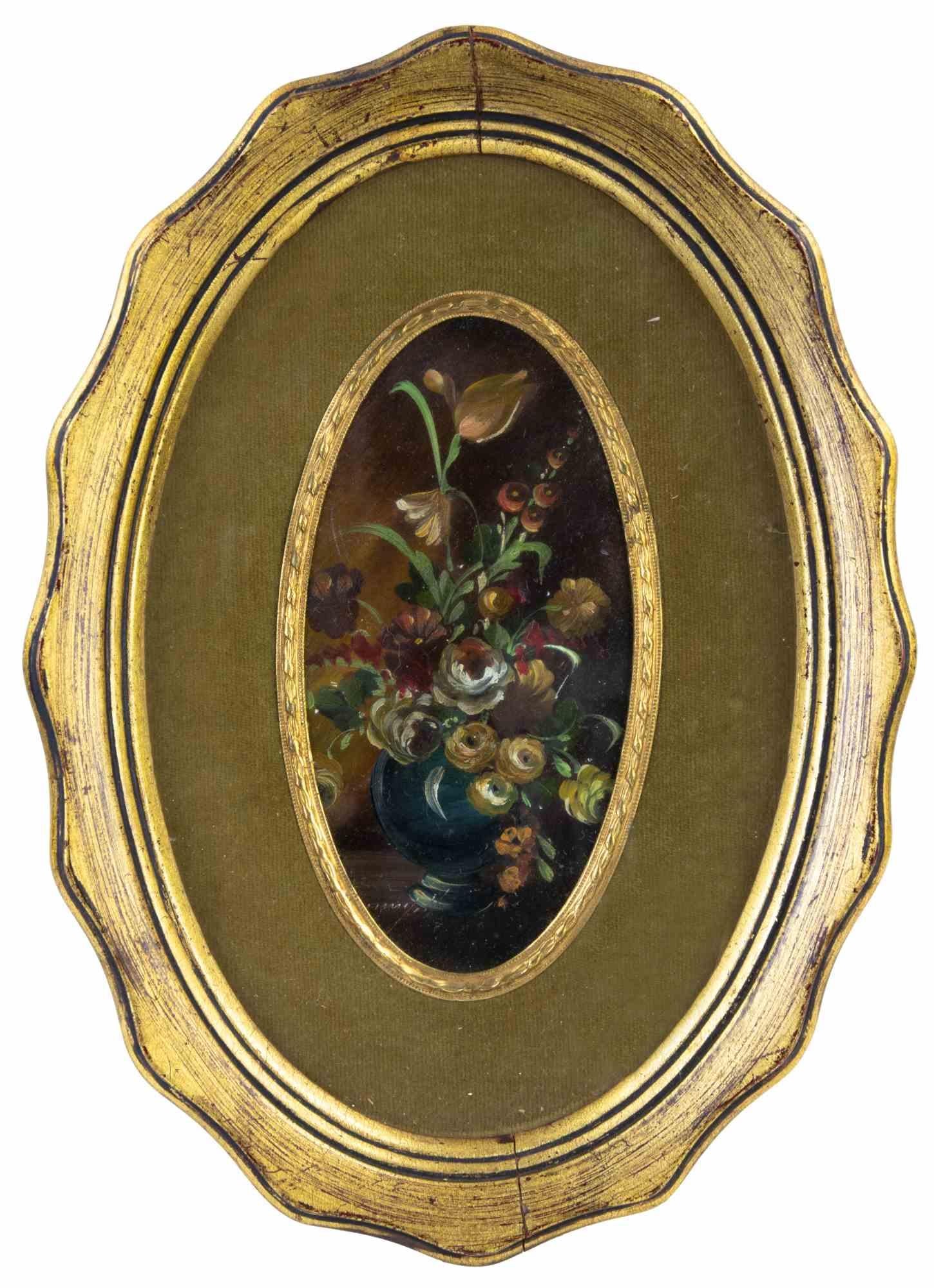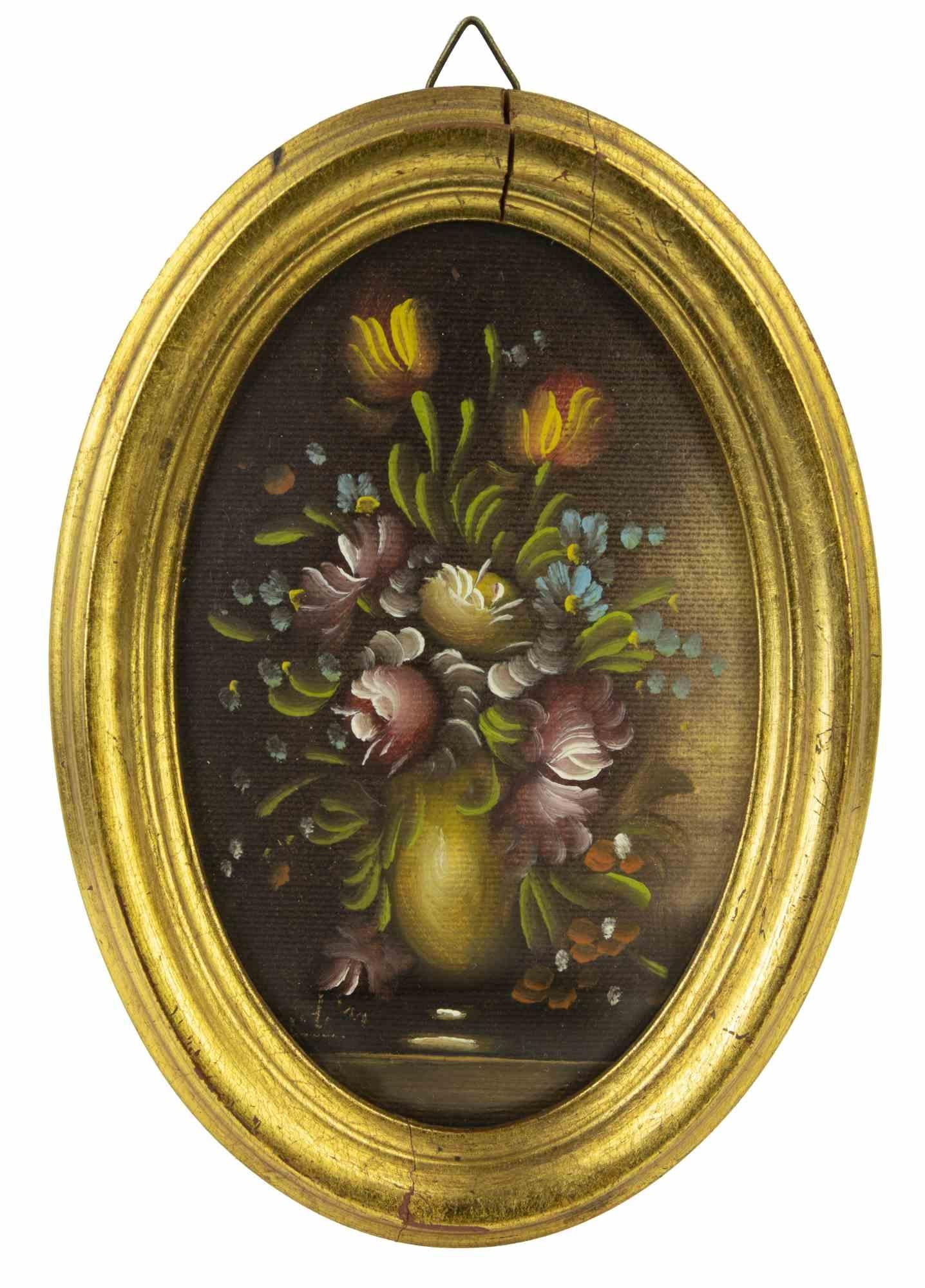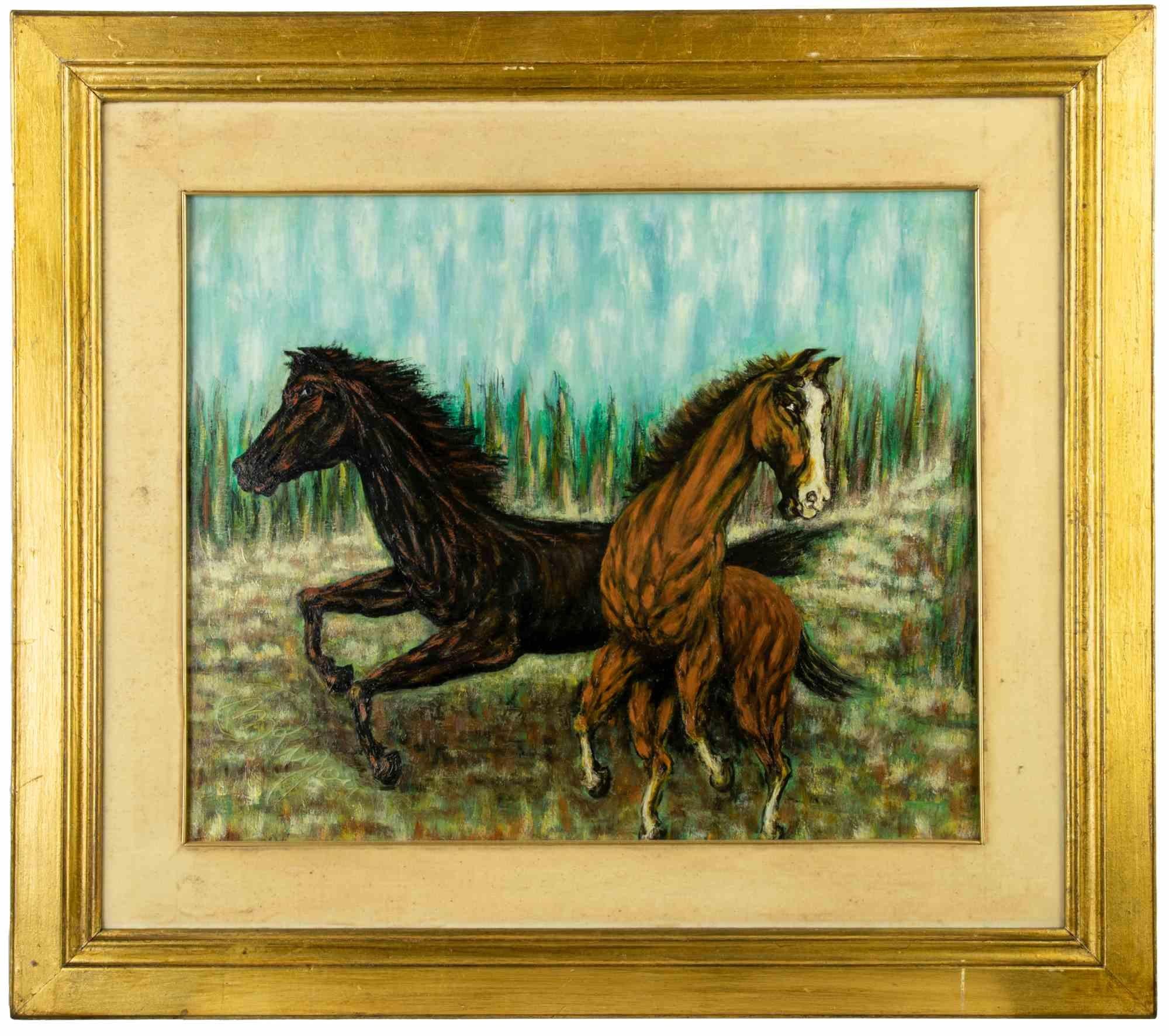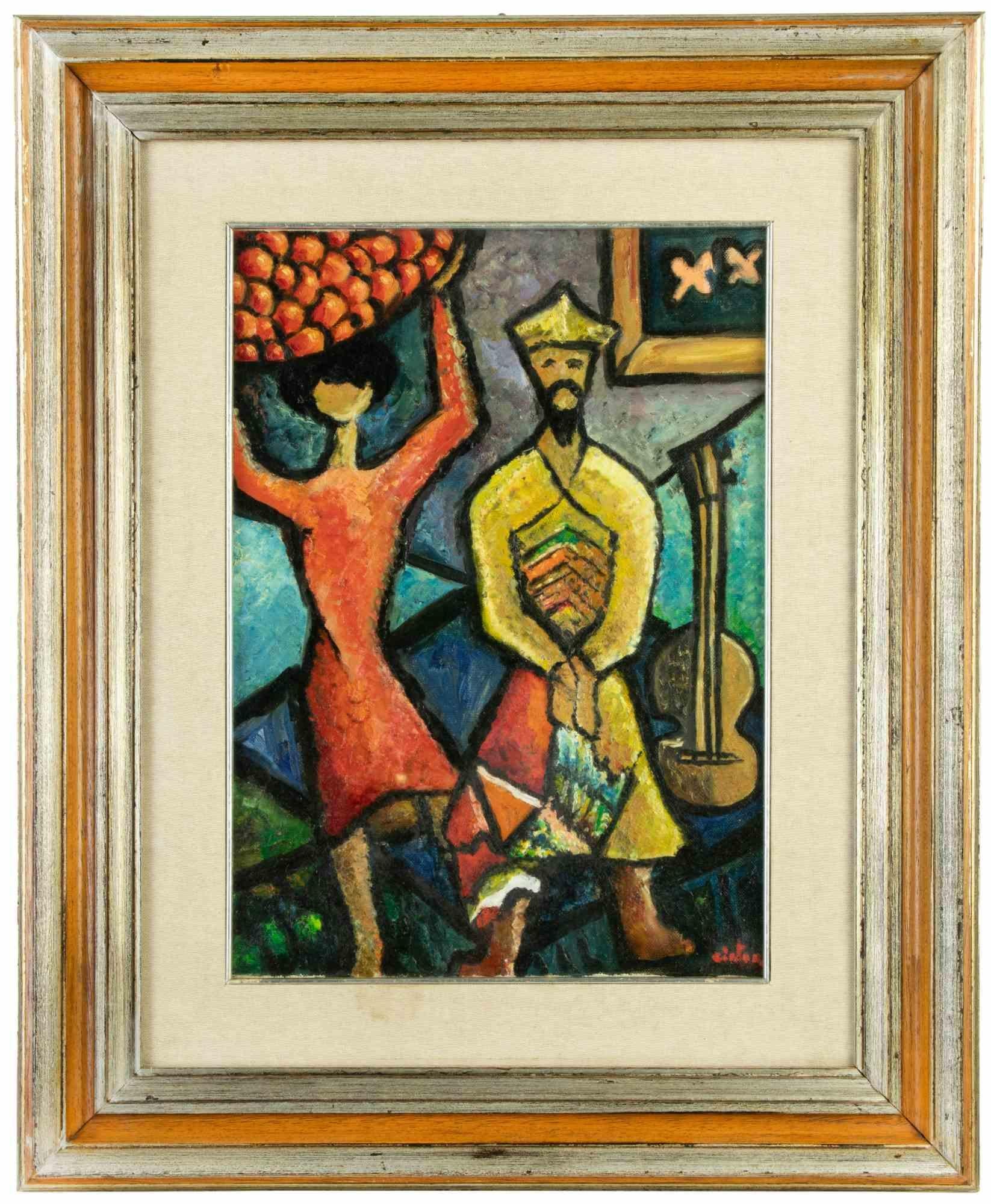Items Similar to The Old World
Want more images or videos?
Request additional images or videos from the seller
1 of 5
Russell CowlesThe Old Worldby 1943
by 1943
About the Item
Old World, by 1943, oil on canvas, signed lower right, 43 ½ x 30 ½ inches, artist’s name and title inscribed verso; exhibited 1) Romantic Painting in America, Museum of Modern Art, New York, NY, November 17, 1943 – February 6, 1944, no. 59; 2) Recent Paintings by Russell Cowles, Kraushaar Galleries, New York NY, March 27 – April 15, 1944 (see a) Cowles at His Best in Ten New Exhibits, The Art Digest, April 1, 1944, p. 16 – “But then, Cowles can be romantic also. Woodland Magic and Old World each in their own way, win this denotation. The first goes so far in the direction of visionary beauty as to call to mind R. L. Newman, in certain passages of ruddy coloration; the second is a vision of ruin, of a crumbling monotonic promontory down which rides an old man and his old horse, and is of this day’s vision – none other.” and b) Devree, Howard, A Reviewer’s Notes Brief Comment on Some Recently Opened Shows – Paintings by Russell Cowles, The New York Times, April 2, 1944 – “One of the outstanding one-man shows of the season is made up of ten paintings – recent oils by Russell Cowles, at Kraushaar’s . . . Except for “Old World,” a dramatic comment on our time which was included in the “Romantic” exhibition at the Museum of Modern Art, and the “Snake Charmer,” included in the recent Whitney annual, none of the ten canvases has been shown before.”) 3) One Hundredth and Fortieth Annual Exhibition of Painting and Sculpture, Pennsylvania Academy of Fine Arts, Philadelphia, PA, January 19 – February 15, 1945, no. 108 (label verso); literature: 1) Miller, Dorothy C. and Thrall, James, Romantic Painting in America, The Museum of Modern Art (1943), p. 133; and 2) Bear, Donald, Russell Cowles, Dalzell Hatfield, designed by Merle Armitage, no. 327 of 1000 copies (1946), plate no. 12, ex collection Kraushaar Galleries (New York) and Dalzell Hatfield Galleries (Los Angeles), presented in its original frame.
This work is part of our exhibition America Coast to Coast: Artists of the 1940s.
Russell Cowles' Old World is a critically acclaimed and well exhibited painting which also serves as a poignant historical record of World War II. Cowles presents to disasters of the war in Europe through the metaphor of a beleaguered old man riding atop a sway-backed horse on the verge of stepping off a cliff into oblivion. The man looks to the rear apprehensively as if running away from some unseen evil force while a vulture looks on in the foreground at the ensuing calamity. The craggy outcropping, punctuated lighting and stormy sky in the background add to the drama. Though devoid of the explicit mayhem of combat, it is hard to imagine a more clear statement against the horrors of war.
Cowles was an eclectic painter who recalled, “I like to paint everything. I want to take the whole field of life. Art is an expression of the human spirit and it finds an endless variety of outlets, all the way from a Chinese landscape of the Tang Period . . . to a religious painting by El Greco to a ‘Guernica’ by Picasso ." A native of Iowa, which Cowles recalled was a “cultural desert,” the young artist’s first exposure to painting was through his mother, who had studied at the Art Institute of Chicago. Cowles graduated from Dartmouth College in 1909 and then decamped to Paris to paint until his money ran out. He made it back to the United States in time for the Armoy Show in 1913 which disturbed and influenced his art in equal measure. After additional time at the Art Student’s League and the National Academy of Design, Cowles was awarded the Prix de Rome to study at the American Academy in Rome, where he stayed for five years, being deeply immersed in the Old Masters.
Upon his return to the United States, Cowles took up a deeper examination of modernism, while the 1920s found him traveling back to Paris and across Asia, soaking up varied influences. In his absence, one of his paintings was awarded the Norman Waite Harris Medal and Prize at the Art Institute of Chicago. After returning to the United States, Cowles moved to Santa Fe where he associated with the painters of the New Mexico group. Cowles later split time between New York City and his farm in Connecticut.
He exhibited extensively during his career, including at the Pennsylvania Academy of Fine Arts, the Salons of America, the Art Institute of Chicago, the Metropolitan Museum of Art, the Museum of Modern Art, the Whitney Museum of American Art, the Los Angeles County Museum of Art, and the Legion of Honor in San Francisco. He was honored with over forty solo exhibitions and was represented by major art dealers on both coasts, including Kraushaar Galleries in New York City and Dalzell Hatfield Gallery in Los Angeles. Cowles is listed in Who Was Who in American Art and all other standard references.
- Creator:Russell Cowles (1887-1979, American)
- Creation Year:by 1943
- Dimensions:Height: 43.5 in (110.49 cm)Width: 30.5 in (77.47 cm)Depth: 3 in (7.62 cm)
- More Editions & Sizes:43.5 x 30.5 inchesPrice: $18,000
- Medium:
- Movement & Style:
- Period:
- Condition:
- Gallery Location:Los Angeles, CA
- Reference Number:1stDibs: LU1859214250602
About the Seller
No Reviews Yet
Vetted Seller
These experienced sellers undergo a comprehensive evaluation by our team of in-house experts.
1stDibs seller since 2022
6 sales on 1stDibs
Typical response time: 5 hours
- ShippingRetrieving quote...Ships From: Los Angeles, CA
- Return PolicyA return for this item may be initiated within 3 days of delivery.
More From This SellerView All
- Six O'ClockLocated in Los Angeles, CASix O-Clock, c. 1942, oil on canvas, 30 x 20 inches, signed and titled several times verso of frame and stretcher (perhaps by another hand), marked “Rehn” several times on frame (for the Frank K. M. Rehn Galleries in New York City, who represented Craig at the time); Exhibited: 1) 18th Biennial Exhibition of Contemporary American Oil Paintings from March 21 to May 2, 1943 at The Corcoran Gallery of Art in Washington, D.C. #87, original price $450 (per catalog) (exhibition label verso), 2) Craig’s one-man show at the Frank K. M. Rehn Galleries, New York City, from October 26 to November 14, 1942, #10 (original price listed as $350); and 3) Exhibition of thirty paintings sponsored by the Harrisburg Art Association at the State Museum of Pennsylvania in Harrisburg in March, 1944 (concerning this exhibit, Penelope Redd of The Evening News (Harrisburg, Pennsylvania) wrote: “Other paintings that have overtones of superrealism inherent in the subjects include Tom Craig’s California nocturne, ‘Six O’Clock,’ two figures moving through the twilight . . . .” March 6, 1944, p. 13); another label verso from The Museum of Art of Toledo (Ohio): original frame: Provenance includes George Stern Gallery, Los Angeles, CA About the Painting Long before Chris Burden’s iconic installation outside of the Los Angeles County Museum of Art, Urban Light, another artist, Tom Craig, made Southern California streetlights the subject of one of his early 1940s paintings. Consisting of dozens of recycled streetlights from the 1920s and 1930s forming a classical colonnade at the museum’s entrance, Burden’s Urban Light has become a symbol of Los Angeles. For Burden, the streetlights represent what constitutes an advanced society, something “safe after dark and beautiful to behold.” It seems that Craig is playing on the same theme in Six O-Clock. Although we see two hunched figures trudging along the sidewalk at the end of a long day, the real stars of this painting are the streetlights which brighten the twilight and silhouette another iconic symbol of Los Angeles, the palm trees in the distance. Mountains in the background and the distant view of a suburban neighborhood join the streetlights and palm trees as classic subject matter for a California Scene painting, but Craig gives us a twist by depicting the scene not as a sun-drenched natural expanse. Rather, Craig uses thin layers of oil paint, mimicking the watercolor technique for which he is most famous, to show us the twinkling beauty of manmade light and the safety it affords. Although Southern California is a land of natural wonders, the interventions of humanity are already everywhere in Los Angeles and as one critic noted, the resulting painting has an air of “superrealism.” About the Artist Thomas Theodore Craig was a well-known fixture in the Southern California art scene. He was born in Upland California. Craig graduated with a degree in botany from Pomona College and studied painting at Pamona and the Chouinard Art School with Stanton MacDonald-Wright and Barse Miller among others. He became close friends with fellow artist Milford Zornes...Category
1940s American Modern Landscape Paintings
MaterialsCanvas, Oil
- Gold Mine, Central City, ColoradoBy Joseph MeertLocated in Los Angeles, CAThis painting is part of our exhibition America Coast to Coast: Artists of the 1930s Goldmine, Central City, Colorado, oil on canvas, 36 x 28 inches, c. 1936, signed lower right, ex collection of Platt Fine Art, Chicago, Illinois (label verso). About the Painting Joseph Meert’s painting, Goldmine, Central City, Colorado, depicts the short-lived resurrection of a once prominent city just outside Denver. Central City was founded in 1859 soon after John Gregory struck gold in the area. As word spread, thousands of miners converged into “Gregory’s Gulch” and its surroundings became known as the “richest square mile on earth.” Mining production quickly increased resulting in Central City to becoming Colorado’s largest city in the early 1860s. Despite some technical difficulties transitioning to lode mining and the rise of competition from Leadville, Central City remained an economic boom town through the turn of the century. But, with every boom, there is a bust. World War I marked the end of Central City’s prominence as ore production ground to a halt and by 1925, the town’s population shrank to only 400 people. The desperation of the Great Depression and a nearly 100% increase in the price of gold lured labor and capital back to Central City. Meert painted in Colorado during the mid-1930s, a time when he created his most desirable works. It is during this period of renaissance that Meert captures one of Central City's outlying dirt streets bordered by 19th century wooden houses from the town's heyday and the more recently installed electric lines leading to a distant gold mine. A lone figure trudges up the hill, a mother with a baby in her arms, putting us in mind of the rebirth of the town itself. Meert had solo exhibitions at the Colorado Springs Fine Arts Center in 1936 and the Denver Art Museum. Although it is not known whether Goldmine, Central City was included in either of these exhibitions, it seems likely. Moreover, the painting is closely related to Meert’s painting, The Old Road, which was painted in 1936 and exhibited at the Corcoran Gallery of Art in Washington, DC and at the Dallas Museum of Art. About the Artist Joseph Meert was a well-regarded painter and muralist, who initially made a name for himself in the American Scene and later as an abstract expressionist. Although initially successful, Meert struggled financially and with mental illness later in life. He was born in Brussels, Belgium, but moved with his family to Kansas City, Missouri. As a child, a chance encounter at the Union Pacific Railyard changed his life. Meert happened upon a worker repainting and stenciling a design on a railroad car. Meert later recalled that this experience introduced him to the idea of being a painter. Without support from his father, Meert obtained a working scholarship to the Kansas City Art Institute. After four years at the Kansas City Art Institute, Meert studied seven years at the Art Students League and in Europe and Los Angeles. At the Art Students League, Meert fell under the spell of Thomas Hart Benton and Stanton MacDonald-Wright. In 1931, he befriended Jackson Pollock. By 1934, Meert was part of the Public Works of Art Project when he met his wife, Margaret Mullin...Category
1930s American Modern Landscape Paintings
MaterialsOil, Canvas
- Riders of Pigeon HillBy Jon CorbinoLocated in Los Angeles, CARiders of Pigeon Hill, c. 1940s, oil on canvas, signed lower right, 24 x 36 inches, label verso with title, artist’s name and address; same information inscribed verso; ex-collection...Category
1940s American Modern Paintings
MaterialsCanvas, Oil
- Untitled (Elevated Platform)Located in Los Angeles, CAThis painting is part of our current exhibition - America Coast to Coast: Artists of the 1940s Untitled (Elevated Platform), 1950, oil on canvas, signed and dated lower right, 30 x...Category
1950s American Modern Paintings
MaterialsCanvas, Oil
- The Landing/Dawn LandingLocated in Los Angeles, CAThis painting is part of our exhibition America Coast to Coast: Artists of the 1940s. The Landing/Dawn Landing, 1944, oil on canvas, signed lower left, 20 x 30, titled verso; exhib...Category
1940s American Modern Paintings
MaterialsCanvas, Oil
- Subway ConstructionLocated in Los Angeles, CAThis painting is part of our exhibition American Coast to Coast: Artists of the 1930s Subway Construction, c. 1928, oil on board, 19 x 15 ¾ inches, signed upper left, artist and title verso; exhibited: 1) 12th Annual Exhibition of the Society of Independent Artists, The Waldorf Astoria, New York NY, from March 9 to April 1, 1928, no. 864 (original price $250) (see Death Prevailing Theme of Artists in Weird Exhibits, The Gazette (Montreal, Quebec, Canada), March 8, 1928); 2) Boston Tercentenary Exhibition Fine Arts and Crafts Exhibition, Horticultural Hall, Boston MA, July, 1930, no. 108 (honorable mention - noted verso); 3) 38th Annual Exhibition of American Art, Cincinnati Art Museum, Cincinnati, OH, June, 1931 (see Alexander, Mary, The Week in Art Circles, The Cincinnati Enquirer, June 7, 1931); and 4) National Art Week Exhibition [Group Show], Montross Gallery, New York, New York, December, 1940 (see Devree, Howard, Brief Comment on Some Recently Opened Exhibitions in the Galleries, The New York Times, December 1, 1940) About the Painting Ernest Stock’s Subway Construction depicts the excavation of New York’s 8th Avenue line, which was the first completed section of the city-operated Independent Subway System (IND). The groundbreaking ceremony was in 1925, but the line did not open until 1932, placing Stock’s painting in the middle of the construction effort. The 8th Avenue line was primarily constructed using the “cut and cover” method in which the streets above the line were dug up, infrastructure was built from the surface level down, the resulting holes were filled, and the streets reconstructed. While many artists of the 1920s were fascinated with the upward thrust of New York’s exploding skyline as architects and developers sought to erect ever higher buildings, Stock turned his attention to the engineering marvels which were taking place below ground. In Subway Construction, Stock depicts workers removing the earth beneath the street and building scaffolding and other support structures to allow concrete to be poured. Light and shadow fall across the x-shaped grid pattern formed by the wooden beams and planks. It is no surprise that critics reviewing the painting commented on Stock’s use of an “interesting pattern” to form a painting that is “clever and well designed.” About the Artist Ernest Richard Stock was an award-winning painter, print maker, muralist, and commercial artist. He was born in Bristol, England and was educated at the prestigious Bristol Grammar School. During World War I, Stock joined the British Royal Air Flying Corps in Canada and served in France as a pilot where he was wounded. After the war, he immigrated to the United States and joined the firm of Mack, Jenny, and Tyler, where he further honed his architectural and decorative painting skills. During the 1920s, Stock often traveled back and forth between the US and Europe. He was twice married, including to the American author, Katherine Anne Porter. Starting in the mid-1920s, Stock began to exhibit his artwork professionally, including at London’s Beaux Arts Gallery, the Society of Independent Artists, the Salons of America, the Cincinnati Art Museum, the Whitney Studio and various locations in the Northeast. Critics often praised the strong design sensibility in Stock’s paintings. Stock was a commercial illustrator for a handful of published books and during World War II, he worked in the Stratford Connecticut...Category
1920s American Modern Figurative Paintings
MaterialsOil
You May Also Like
- Figures - Oil on Canvas - Late 20th CenturyLocated in Roma, ITFigures is an artwork realized by an unknown in the late 20th century. Oil on Canvas. Handsigned in the lower margin. Unreadable signature. 44,5 x31,50 cm ; 70 x 57 cm. Good con...Category
1970s Modern Figurative Paintings
MaterialsOil, Canvas
- Horses - Oil on Canvas - 1991Located in Roma, ITHorses an artwork realized by an unknown artist, in 1991. Oil on Canvas. Handsigned in the lower margin. Unreadable signature. 47 x 57.5 cm ; 73 x 83 cm. Good conditionsCategory
1990s Modern Figurative Paintings
MaterialsOil, Canvas
- Still Life - Oil on Canvas - Late 19th centuryLocated in Roma, ITStill Life is an artwork realized by an unknown artist in the late 19th Century. Oil on Canvas Mounted on Board. 18 x 13 cm. Good conditionsCategory
Late 19th Century Modern Still-life Paintings
MaterialsOil, Board, Canvas
- Still Life - Oil on Canvas - Late 19th centuryLocated in Roma, ITStill Life is an artwork realized by an unknonwn artist in the late 19th Century. Oil on Board. 21 x 15 cm. Good conditionsCategory
Late 19th Century Modern Still-life Paintings
MaterialsOil, Board, Canvas
- Landscape - Oil on Canvas by Alberto Sillani - Mid-20th CenturyLocated in Roma, ITLandscape is an artwork by Alberto Sillani, realized in the mid-20thCentury. Oil on Canvas 49 x 39.5 cm ; 75 x 65 cm with frame. Handsigned in the lower margin. Good conditionsCategory
Mid-20th Century Modern Figurative Paintings
MaterialsOil, Canvas
- Bear Witch ProjectBy Robert McCauleyLocated in Denver, COWhen I think of where McCauley fits into American art, as a contemporary painter, sculptor and naturalistic interpreter, I place him in the same philosophical tribe as Walton Ford, A...Category
2010s American Modern Animal Paintings
MaterialsCanvas, Oil, Wood Panel
Recently Viewed
View AllMore Ways To Browse
By The By Vintage
Old Well
World War Ii Art
World Plate
Old World Paintings
Old Time Vintage
American Old Painting
Old World Vintage
Old Vintage Painting
Old Vintage Paintings
Worlds Away
Old New York Paintings
Best Of Both Worlds
Vintage World Travel
Old Young Paintings
Old World Masters
From The Second World War
Modern Old Masters





